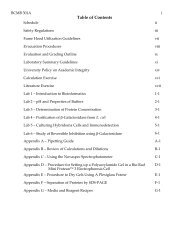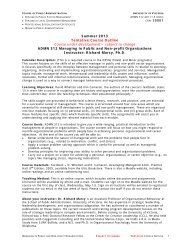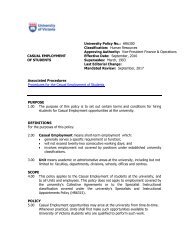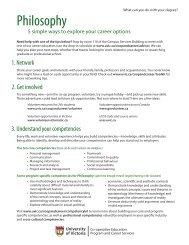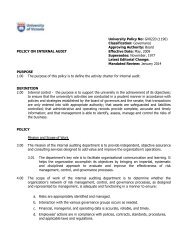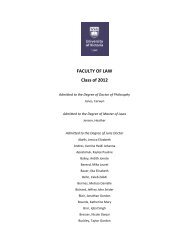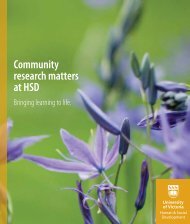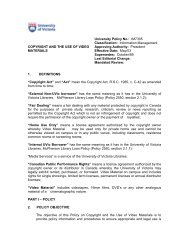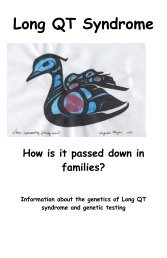Complexity Science Knowledge Synthesis
Complexity Science Knowledge Synthesis
Complexity Science Knowledge Synthesis
Create successful ePaper yourself
Turn your PDF publications into a flip-book with our unique Google optimized e-Paper software.
<strong>Complexity</strong><br />
<strong>Science</strong><br />
<strong>Knowledge</strong><br />
<strong>Synthesis</strong><br />
Resources<br />
Wanda Martin, Robyn Wiebe,<br />
Anne-Mette Hermansen,<br />
Rachelle Beveridge, Simon<br />
Carroll & Marjorie McDonald<br />
28/07/2012
Introduction<br />
The Core Public Health Functions Research Initiative (CPHFRI) has identified a serious gap in knowledge<br />
concerning how to apply ‘complex adaptive systems’ (CAS) concepts to help guide policy planning,<br />
implementation and evaluation for public health interventions. Public health interventions are sociopolitical<br />
and socio-technical interventions in social systems and are aimed at improving both health and<br />
health equity toward a more socially just society. We feel that working from a systems perspective is one<br />
way to improve social justice and reduce health inequities. There is a need to critically assess and integrate<br />
CAS concepts into innovative public health strategies as a high priority but the way to accomplish these<br />
goals remains elusive and challenging. This resource list is a starting point to work toward these goals. It<br />
has developed from a Canadian Institutes of Health funded metanarrative review of systems thinking in<br />
public health. The purpose of the metanarrative review was to map and synthesize existing conceptual and<br />
disciplinary approaches to CAS in order to critically assess their potential usefulness and feasibility for<br />
guiding the planning, implementation and evaluation of population health interventions. This document is<br />
a compilation of approaches to CAS.<br />
The CPHFRI team members are interested in what research methods and approaches have been used in<br />
complexity science studies, particularly evaluations of social and/or public health interventions, and to start<br />
to identify the strengths and limitations of various research methods and approaches to the application of<br />
systems thinking. Secondly, we want to provide practical guidelines, methods, and tools that may be used<br />
for applying complexity science concepts to the development and analysis of public health interventions.<br />
To address these objectives, we conducted a targeted literature search specifically for tools, frameworks<br />
and methodologies related to complexity science. The purpose of this search was to identify resources that<br />
would have a practical application for our study knowledge-users. This was done through the work of a<br />
librarian searching Medline (1946 to February 1, 2012) and EMBASE (1980 to February 1, 2012) to identify<br />
methods and tools that are used to apply systems thinking to public health practice. Team members also<br />
contributed literature they found as appropriate. This is not meant to be an exhaustive list, but to offer a<br />
beginning direction for applying complexity and systems thinking methods, and to highlight methods that<br />
apply to public health intervention research.<br />
We reviewed the abstracts and selected what we identified as a method or tool that could be replicated<br />
either in applied research or contained explanations of tools to evaluate programs or policy from a<br />
complexity or systems perspective. While we attempted to create discrete categories, it is impossible to<br />
fully appreciate the needs of the users of this document. From our perspective of a research team that has<br />
been reading this literature for the past year, we sorted the resources in three ways:<br />
1. Resources that are easy to apply and learn or ways to introduce systems thinking. This includes<br />
frameworks or lenses that may help to guide policy planning, interventions or evaluations of public health<br />
interventions.<br />
2. Resources that require a workshop, or consultant guidance. This section includes those resources<br />
that may be more complex frameworks or more simple and straightforward research methods that can<br />
easily be applied to practice areas with minimal guidance. It is challenging to identify what is purely a<br />
1
simple or easy resource to use, so this category includes resources that could appear easy for some but<br />
more challenging for others.<br />
3. Resources that require expertise. This category of resources includes research methods and<br />
approaches that would require extensive knowledge or time and may best be used with an expert or<br />
research team. They are considered more involved in time and effort, and require a certain amount of<br />
expertise to do well. There may be some resources in this category that only require minimal guidance,<br />
depending on the experience and strengths of those involved.<br />
In the following table (Table 1), we identify the methods and approaches to studying or implementing<br />
systems thinking according to what can help decision makers manage complexity in their organizations. We<br />
developed a short synopsis for each resource. The synopsis for the first two categories includes a<br />
description of the resource, how it links to complexity science or systems thinking, and the strengths and<br />
limitations according to the particular reviewer or noted in the paper. The third section is merely a<br />
description of the research method as an overview to what we have currently identified as more<br />
complicated methods to study complex systems. These comments on each resource are simply here to<br />
help orient you to possibilities on how to apply CAS concepts to help guide policy planning, implementation<br />
and evaluation for public health interventions. The appendix in this document (Table 2) is a list of all the<br />
methods or tools we have identified for practical use or for research in this area, and the references of<br />
papers that will provide further information on the noted resource.<br />
This is a work in progress as we are continually stumbling upon new and innovative ways to guide the work<br />
in population and public health interventions. We welcome feedback on this document and look forward to<br />
expanding our tool box as we work toward improved health equity and a more just society.<br />
Please send any comments to cphfri@uvic.ca.<br />
2
Table 1 Methods/Approaches Reviewed<br />
Practical/Easy to Apply Require Some Guidance Require Some Expertise<br />
Places to intervene in a system Causal loop diagrams Action Research<br />
Five Elements Concept Mapping Agent-based modeling<br />
Generic Five Level Framework<br />
(5LF)<br />
IPE Inter-professional Education<br />
Intervention<br />
3<br />
Case Study<br />
Health in Cities Framework Positive Deviance Community Operational Research<br />
Intervention Level Framework Program Budgeting and Marginal<br />
Analysis (PBMA)<br />
LENSES (Living Environments in<br />
Natural, Social, and Economic<br />
Systems)<br />
Computational modelling,<br />
simulation<br />
Soft Systems Methodology Reality Mining<br />
Liberating Structures Systems Dynamic Modeling Situational Analysis/Grounded<br />
Theory<br />
Behavior Over Time Graphs Viable Systems Model Discrete Event Simulation (DES)<br />
Systems-in-transition paradigm<br />
for healthy communities<br />
Resources Easy to Apply<br />
Grounded Neural Networking<br />
using a self-organizing map<br />
Mathematical modeling<br />
Organizational network analysis<br />
(ONA)<br />
Social Network Analysis<br />
Structural Leverage Analysis<br />
Places to Intervene in a System<br />
Meadows, D. (1999). Leverage Points: Places to intervene in a system. The Sustainability Institute, Hartland,<br />
VT. Retrieved from: http://www.sustainabilityinstitute.org/pubs/Leverage_Points.pdf<br />
This is an ordered list of places or points to intervene within a system in order to create effective change.<br />
It is an invitation to think more broadly about the many ways there might be to create system change.<br />
Describes places within a system to intervene. The “places to intervene” are described and ordered<br />
according to effectiveness.<br />
9. Constants, parameters, numbers<br />
8. Regulating negative feedback loops
7. Driving positive feedback loops<br />
6. Material flows and nodes of material intersection<br />
5. Information flows<br />
4. The rules of the system<br />
3. The distribution of power over the rules of the system<br />
2. The goals of the system<br />
1. The mindset or paradigm out of which the system, its goals, power, structure, rules and culture arises.<br />
Strengths: Helps change the way people think about a system.<br />
Limitations: Each point could probably use more reading to understand where to take it. The placement of<br />
each item on the list is very tentative. An item could easily move up or down on the list.<br />
The Five Elements Guide<br />
Lundholm, K., & Richard, R., (2005). The Five Elements Guide. Structured information to help engage<br />
individuals to act strategically towards sustainability. Retrieved from<br />
http://www.apreis.org/docs/5elements_guide.pdf.<br />
This resource is limited to sustainability and environmental initiatives, but is included because it may be<br />
adaptable as an introduction to systems thinking.<br />
Informed by systems thinking, the Five Elements Guide provides a strategic resource for engaging<br />
individuals in sustainability activities and societal change. In other words, this resource focuses on<br />
individuals and their motivation and capacity for change. The Five Elements Guide was developed by two<br />
Swedish authors building on their personal knowledge and experience, as well as a trans-disciplinary<br />
literature review. It offers an approach for creating and improving engagement strategies for societal<br />
change.<br />
Strengths: The Five Elements Guide offers a simple, detailed and flexible approach for engaging individuals<br />
in strategic change related to sustainability. It describes a number of tools and resources for the concepts<br />
and notions (i.e. change and systems) related to sustainability and systems thinking, and use case<br />
examples.<br />
Limitations: As documented by the authors, the Five Elements Guide could improve from further feedback,<br />
development, and testing. Also, the guide is focused primarily on the “individual” system, rather than the<br />
system as a whole.<br />
The Generic Five Level Framework (5LF)<br />
Peters, A., Chen, P., Wetherell, R., & Valeris, Y. (2009). Seeds of change: Using urban agriculture to move<br />
cities towards sustainability (Master’s Thesis). Retrieved from www.sea-mist.se.<br />
This is a basic resource that may be adapted to public health and provides an introduction to systems<br />
thinking.<br />
4
The Five Level Framework (5LF) is a planning model informed by systems thinking, and can be applied to<br />
any complex system with a particular desired outcome. This thesis explores how urban agriculture can be<br />
supported to help move cities towards sustainability. The five levels consist of system, success, strategic,<br />
action, and tools. According to the authors, 5LF is applicable in all planning contexts, whether local,<br />
regional or national.<br />
Strengths: 5LF provides a basic model for planning. 5LF applied to urban agriculture is the foundation of the<br />
framework for sustainable strategic development used in this same study.<br />
Limitations: 5LF is quite basic.<br />
Health in Cities Framework<br />
Glouberman, S., Gemar, M., Campsie, P., Miller, G., Armstrong, J., Newman, C., Siotis, A., & Groff, P. (2006).<br />
A framework for improving health in cities: A discussion paper. Journal of Urban Health, 83(2), 325-<br />
338.<br />
This resource offers a framework for intervening in the health of urban city residents.<br />
The Health in Cities framework builds from the healthy cities movement. The framework aims to create<br />
effective health interventions for people living within urban environments. The framework recognizes that<br />
there are multiple and sometimes competing issues within an urban environment. Each city is unique and<br />
comprised of a variety of groups. The Health in Cities framework conceptualizes cities and health as<br />
complex adaptive systems (CAS), and consists of 7 components for developing effective health<br />
interventions: 1) gather local information; 2) respect history; 3) consider interaction; 4) promote variation;<br />
5) conduct selection; 6) fine tune process; and 7) encourage self-organization.<br />
Strengths: Builds on the traditional urban health and healthy city movements. The framework recognizes<br />
the strengths or assets of a city, not merely the issues or needs.<br />
Limitations: This resource offers a nice framework, but may be limited to urban health settings.<br />
Intervention Level Framework<br />
Malhi, L., Karanfil, O., Merth, T., Acheson, M., Palmer, M. & Finegood, D. T. (2009). Places to intervene to<br />
make complex food systems more healthy, green, fair, and affordable. Journal of Hunger &<br />
Environmental Nutrition, 4(3-4), 466-476.<br />
This is a simple and concise framework useful for helping stakeholders understand systems and create<br />
system-wide change.<br />
The authors adapted Meadow’s “12 places to intervene” framework into a 5 level framework (paradigm,<br />
goals, system structure, feedback and delays, and structural elements). The Intervention Level Framework<br />
was used to sort qualitative data related to food systems. In other words, the authors used the food system<br />
as an example to apply the framework by looking at the five levels: paradigm, goals, system structure,<br />
feedback and delays, and structural elements. According to the authors, “With the Intervention Level<br />
Framework, stakeholders can develop a better understanding of how coherent actions among and<br />
between subsystems, together with enhanced self-regulating feedback loops and interconnections<br />
between subsystems, can create system-wide change” (p. 476).<br />
5
Strengths: A simple and concise framework.<br />
Limitations: May be too simplistic.<br />
LENSES (Living Environments in Natural, Social, and Economic Systems)<br />
Plaut, J. M., Dunbar, B., Wackerman, A., & Hodgin, S. (2012). Regenerative design: The LENSES Framework<br />
for buildings and communities. Building Research & Information, 40(1), 112-122.<br />
This is a whole-systems framework that promotes healthy, natural, social and economic system<br />
development.<br />
LENSES works from the understanding that positive and improved development requires a whole-systems<br />
approach to design that generates relationships among ecological, economic, and social issues. As such,<br />
LENSES attempts to shift the focus from individual elements within a system, to the patterns, connection<br />
and relationships between elements in a system. The LENSES framework is appropriate for small and large<br />
projects across all programme areas. The aim of LENSES is to inspire and create development and change<br />
that supports the creation of healthy, natural, social and economic systems.<br />
Strengths: According to the authors, LENSES framework represents the best information related to<br />
sustainability. LENSES framework is user-friendly, and adaptable to a variety of contexts. Also, LENSES<br />
encourages people to consider concepts and elements often missing in other resources (i.e. inclusivity,<br />
financial sourcing, cultural resources, regional context, education, shared authority and governance, and<br />
on-going prosperity).<br />
Limitations: LENSES is quite new, and is not well tested.<br />
Liberating Structures<br />
Lipmanowicz, H. (n.d.). Liberating structures: Innovating by including and unleashing everyone. Retrieved<br />
from: www.plexusinstitute.org/resource/resmgr/docs/liberating_structures_articl.pdf<br />
This is a compilation of 31+ methods designed to stimulate creativity and innovation.<br />
Inspired by complexity science, and developed from the Plexus Institute, LS consists of over 31 methods to<br />
inspire people towards innovation. LS has successfully been used in the pharmaceutical industry, who it<br />
was developed for, as well as hospitals, nongovernmental organizations (NGOs), government agencies and<br />
academic institutions. LS aim to change the pattern of interactions within a group, in order to stimulate<br />
creativity and innovation. People from all levels are encouraged to use their voice, participate and<br />
contribute.<br />
Strengths: LS is an easy approach that requires little time investment. According to the authors, one or two<br />
experiences with LS are enough practice for anyone to begin experimenting with the resources. LS support<br />
practice that is congruent with complexity science, but does not require that people have experience<br />
related to complexity theory/science.<br />
Limitations: None identified.<br />
6
Behaviour-over -time Graphs<br />
BeLue, R., Carmack, C., Myers, K., Weinreb-Welch, L., & Lengerich, E. (2012). Systems thinking tools as<br />
applied to community-based participatory research: A case study. Health Education Behavior. Epublication<br />
before print. doi: 10.1177/1090198111430708.<br />
Systems thinking tools serve to describe and understand Complex Adaptive Systems (CAS). A CAS is a<br />
dynamic network of many heterogeneous agents (e.g. individuals, groups, organizations) that interact<br />
freely and in ways that are nonlinear (inputs not necessarily proportional to outputs) and not necessarily<br />
predictable (Anderson, Crabtree, McDaniel, & Steele, 2005; McDaniel, 1999). Systems thinking tools, such<br />
as behaviour-over-time graphs, help visualize the overall system structures and relationships. They allow<br />
stakeholders to understand the many different components and their interrelations, thereby making it<br />
easier to identify appropriate points of intervention.<br />
Behavior-over-time graphs are similar to other basic graphs in that they have horizontal and vertical axes.<br />
These graphs are used to plot a behavior of interest (vertical axis) over time (horizontal axis) so that the<br />
behavior can be examined from a systems thinking perspective.<br />
Strengths: Relatively simple and help to identify patterns of changes over time. It has been used in public<br />
health for years.<br />
Limitations: You need to have the data in a constant form over time.<br />
Systems-in-Transition Paradigm for Healthy Communities<br />
English, J.C.B. & Hicks B.C. (1990). A systems-in-transition paradigm for healthy communities. Canadian<br />
Journal of Public Health, 83(1), 61-65.<br />
This is a conceptual diagram to organize community into five functional interdependent subsystems of 1)<br />
production; 2) social control; 3) social participation; 4) socialization; and 5) mutual support, and describes<br />
the process of community development and stress. It is intended to aid in holistic community assessment.<br />
The paradigm is built on general systems theory to help practitioners think about the way a community is<br />
organized.<br />
Strengths: Easy to follow diagrams to consider the impact of stress, adaptation and change.<br />
Limitations: Not well used for seeing how well this has been applied.<br />
Resources that Require Guidance<br />
Casual Loop Diagrams (CLD)<br />
BeLue, R., Carmack, C., Myers, K., Weinreb-Welch, L., & Lengerich, E. (2012). Systems thinking tools as<br />
applied to community-based participatory research: A case study. Health Education Behavior. Epublication<br />
before print. doi: 10.1177/1090198111430708.<br />
7
CLD provide a new take on the traditional perception of cause and effect in organizational relationships.<br />
They break with the idea that decisions and their outcomes constitute linear relationships by showing that<br />
interrelated variables create feed-back loops that ultimately complicate the outcomes of decisions and<br />
effects of interventions. The diagram provides a visual representation of the most salient variables in a<br />
system or an intervention and how these variables are related to one another. The diagram includes<br />
descriptions of the various connections between the variables and how these might impact one another<br />
and cause change. This tool may be used as a starting point for model conceptualization of a problem or an<br />
intervention to help portray the larger system that said problem or intervention is part of, and identify<br />
specific relationships of interest.<br />
Strengths: A benefit to using CLD is that it quickly and easily helps people new to systems thinking grasp<br />
the basic concepts of this kind of analysis and understand how to implement systems thinking tools. Causal<br />
loop diagrams may provide an initial basis for simulation modeling in which a variety of futures can be<br />
explored and leverage points can be more accurately identified.<br />
Limitations: The actual diagram may lack some relevant variables, and errors are present in the connection<br />
/loop structure. Adequate training is necessary to properly use and benefit from this tool.<br />
Concept Mapping<br />
Trochim, W., Cabrera, D., Milstein, B., Gallagher, R., & Leischow, S. (2006). Practical challenges of systems<br />
thinking and modeling in public health. American Journal of Public Health, 96(3), 538-546.<br />
While Systems thinking is a general conceptual orientation concerned with the idea of interrelations<br />
between multiple agents in a complex structure, systems modelling is a methodological tradition<br />
concerned with operationalizing systems thinking by using models and simulations. Concept mapping is<br />
one such model. It enables users to develop a shared conceptual framework that can be used in a variety of<br />
policy contexts to identify or encourage complexity. System effects are thereby made transparent and<br />
power disparities are highlighted, by using a systematic and formalized research tool.<br />
Concept mapping is a web-based model that organizes statements generated by a group of people,<br />
concerned with a particular topic, into piles of synthesized statements. The piles are statistically analyzed<br />
and configured into a map that shows clusters of statements, with the more similar ones located closer to<br />
each other. When users look at the map and plan or evaluate interventions based on them, they engage in<br />
a continuous process where planning, action and evaluation intertwine and continuously adapt to one<br />
another.<br />
Strengths: Concept mapping is a model that is very accessible for diverse groups of people and therefore a<br />
gateway to incorporate complexity into public health interventions. The method is inductive and allows<br />
shared meaning to emerge. As it is based on a simple set of rules (operations) that generate a visual<br />
representation of complex patterns and results, it can help a diverse group of users engage with multiple<br />
ideas for planning, executing, and evaluating interventions simultaneously as it provides a framework that<br />
enable users to align action with a broader organizational or systems vision.<br />
Limitations: The web-based model is expensive and the cost is applied for each use.<br />
8
Inter-Professional Education Intervention<br />
Cooper, H., Spencer-Dawe, E. & McLean, E. (2005). Beginning the process of teamwork: Design,<br />
implementation and evaluation of an inter-professional education intervention for first year<br />
undergraduate students. Journal of Interprofessional Care, 19(5), 492-508.<br />
Inter-Professional Education (IPE) is an intervention tool and evaluation tool. The intervention involved a<br />
number of key developments including a staff-training programme, generic e-learning materials, and a<br />
student team-working skills intervention. Provided this way it requires a trainer and a group setting. The<br />
intervention is therefore best used with a group of students, a professional team, an office, or other groups<br />
of health care providers that work together across disciplines.<br />
This paper refers to the authors’ 2004 paper on <strong>Complexity</strong> and Inter-Professional Education where the<br />
theory is discussed. It references Campbell’s guide to evaluation of health promotion interventions that are<br />
complex, pragmatic and context dependent. The learning process of IPE is in line with systems thinking: it<br />
enables competence and capability to adapt to change. <strong>Complexity</strong> theory, with its focus on connectivity,<br />
diversity, self-organization, and emergence, can provide IPE with a coherent theoretical foundation, freeing<br />
it from the constraints of a traditional linear framework, enabling it to be better understood, questioned<br />
and challenged as a new paradigm of learning. The pilot project found it promoted theoretical learning<br />
about team working, enabled students to learn from and with each other, and raised awareness about<br />
collaborative practice.<br />
Strengths: In a pilot project it was used to enable students from different professional groups to work<br />
together, learn from each other, and improve the effectiveness of team work to impact health care delivery<br />
positively.<br />
Limitations: In the pilot project the intervention was targeted at first year students. This group of learners<br />
might be more receptive to it than older students or already established researchers/practitioners.<br />
Furthermore, the intervention requires time as there is a learning process. It might be beneficial to try to<br />
implement the intervention in “real life” settings rather than in educational settings, to maximize its effect<br />
and speed up the learning curve.<br />
Positive Deviance (PD)<br />
Tufts University. (2010). Basic field guide to the Positive Deviance (PD) approach. Retrieved from<br />
www.positivedeviance.org.<br />
Positive Deviance (PD) is a concept that was operationalized by American academics in the 1990’s as a tool<br />
to create social change. It is based on the observation that in every community there are individuals or<br />
groups of individuals (called Positive Deviants), where uncommon but successful behaviors or strategies<br />
enable them to find better solutions to certain problems than other community members.<br />
A PD solution to a problem is found following the basic guideline disseminated by the Positive Deviance<br />
Initiative, a global organization with an online presence. There are four steps to the process: 1) define the<br />
problem, 2) determine the presence of PD individuals or groups in the community, 3) discover uncommon<br />
but successful behaviours or strategies through inquiry and observation, and 4) design a solution based in<br />
activities that allow other community members to practice the discovered behaviours or strategies.<br />
9
Strengths: PD is an asset-based approach to solving problems which taps into the unrealized and unused<br />
resources that a community may possess by amplifying such uncommon behaviours and strategies<br />
discovered by otherwise unsuccessful members of the community. It is used to solve complex problems on<br />
a global scale (but from a local vantage point) in diverse sectors, among them public health and education.<br />
Limitations: PD is easy to apply, but requires the participation of an entire community, as well as leadership<br />
commitment to address the problem. Also, it is best applied to complex problems that that are social in<br />
nature and require behavioural and or social changes, more so than purely technical solutions.<br />
Program Budgeting & Marginal Analysis (PBMA)<br />
Mitton, C., Donaldson, C. (2004). Priority setting toolkit: a guide to the use of economics in healthcare<br />
decision making. London, BMJ Publishing Group.<br />
PBMA provides an economic framework and assists with priority setting in healthcare systems. There are 7<br />
stages: defining the aim and scope; developing a program budget; creating an advisory group; developing<br />
decision making criteria; identifying options for investment and disinvestment; evaluating options; and<br />
validating results and the reallocation of resources.<br />
Strengths: Provides transparency of spending, involves high level consultation, realistic approach to<br />
planning; uses multiple sources of information.<br />
Limitations: Difficult to prioritise over different sectors; lack mechanism to implementation<br />
recommendations; need to overcome organizational barriers to change. (See Willis et al., 2012 reference<br />
for more on strengths and limitations)<br />
Soft Systems Methodology<br />
Checkland, P., Poulter, J. (2006). Learning for Action: A Short Definitive Account of Soft Systems<br />
Methodology, and Its Use Practitioners, Teachers and Students, Chichester. UK: Wiley.<br />
Soft Systems Methodology (SSM) is a process of inquiry that organizes thinking about complex situations so<br />
action can be taken to improve a situation. The authors describe a process where a problem is perceived,<br />
world views identified and different people are taking action on the problem. Models of the activities are<br />
created that open a space for discussion about changes that are both desirable and feasible, to find a<br />
version of the situation that is acceptable to different worldviews, and then changes can be implemented,<br />
continuing the cycle to work out the challenges. It is considered to be a direct response to real-life<br />
experiences.<br />
Strengths: It helps to focus situations where there is strong discontent without clear direction, and helps to<br />
make sense of ambiguous situations. It encourages positive attitudes and good communication. Considers<br />
clashing worldviews as opportunities for energetic and motivating creativity.<br />
Limitations: Skilled facilitator is needed to encourage respectful negotiation between clashing worldviews.<br />
Systems Dynamics Modeling<br />
Hirsch, G., Levine, R., & Miller, R. (2007). Using system dynamics modeling to understand the impact of social change<br />
initiatives. American Journal of Community Psychology, 39(3-4), 239-253.<br />
10
Homer, J., & Hirsch, G. (2006). System dynamics modeling for public health: Background and opportunities. American<br />
Journal of Public Health, 96(3), 452-458.<br />
Creative Learning Exchange: Systems Dynamics and Systems Thinking in K-12 Education. Produced by MIT in 1994 and<br />
revised in 2005. Retrieved from: http://clexchange.org/curriculum/roadmaps.asp.<br />
Jones, J.E., Milstein, B., Murphy, D., Seville, D. (2006). Systems Thinking: A Practical Application. Participant Exercises.<br />
Sustainability Institute, Center for Public Health Practice, Rollins School of Public Health, Emory University.<br />
Retrieved from: www.sustainer.org/pubs/SI06JonesBO1Final.pdf.<br />
Systems Dynamics Modelling is a way to map and thereby understand the many forces at play in complex<br />
systems. It also recognizes the tendency of such systems to be in a constant state of change, and thereby<br />
delay, defeat or dilute the intended effects of planned interventions. While Systems Dynamics Modelling is<br />
not a tool to predict the behaviour of a complex system (a characteristic of which is that it is<br />
unpredictable), the modelling can help users ask relevant questions to proposed interventions. More<br />
importantly, the modelling enables diverse stakeholders to combine their knowledge and develop dynamic<br />
hypotheses and test these against computer simulations that play out multiple possible scenarios of<br />
change to an intervention.<br />
A good place to start for learning and using Systems Dynamics Modelling is Road Maps – a self-study guide.<br />
It was developed by the System Dynamics in Education Project (SDEP) at MIT under the direction of<br />
Professor Jay Forrester. Organized as a series of chapters, ten chapters of Road Maps are available for<br />
download. Road Maps teach the reader how to identify different kinds of systems all around us and how to<br />
model these systems. Road Maps can be a resource for both beginners and advanced System Dynamics<br />
modellers. It requires no previous System Dynamics knowledge and only basic math skills. However, some<br />
time and practice is needed to go through the program.<br />
Strengths: The first step in systems dynamics modelling is causal loop diagrams providing a map of the<br />
system and interactions of the parts. Helps to highlight workings of a system and the consequences of<br />
decisions.<br />
Limitations: You need good data to put into the equations. Special software is required<br />
Viable Systems Model<br />
Beer S. (1984). The viable system model: Its provenance, development, methodology and pathology.<br />
Journal of Operational Research Society, 35, 7–25.<br />
Midgley, G. (2006). Systemic intervention for public health. American Journal of Public Health, 96(3), 466<br />
The Viable Systems Model comes out of organizational science, and emphasises communication among five<br />
functions of an organization: operations or the provision of needed services; effective coordination;<br />
support and control for things like resources, training and information; intelligence or the forecasting for<br />
needs, opportunities and threats; and policy making for long term goals and objectives. The success of an<br />
organization is that it is adaptable.<br />
Strengths: Appears to be an easy, straight forward model to follow, with a long track record.<br />
Limitations: None noted.<br />
11
Research Methods<br />
In this section we will only give a brief overview because this primarily relates to research methods<br />
requiring more in-depth training.<br />
Action Research from a Systems Perspective<br />
Midgley, G. (2003). <strong>Science</strong> as systemic intervention: Some implications of systems thinking and complexity<br />
for the philosophy of science. Systemic Practice and Action Research, 16(2), 77-97.<br />
This paper is about conceptualizing research as an intervention. Systemic intervention is purposeful action<br />
by an agent to create change in relation to reflection on boundaries. Methodology for systemic<br />
intervention should be explicit about three things: boundary critique, theoretical and methodological<br />
pluralism, and action for improvement.<br />
More traditionally, action research engages the system “insiders”, and when working toward system<br />
change, this can be a very powerful research method.<br />
Agent-based Modeling<br />
Anderson, J., Chaturvedi, A., & Cibulskis, M. (2007). Simulation tools for developing policies for complex<br />
systems: Modeling the health and safety of refugee communities. Health Care Management<br />
<strong>Science</strong>, 10(4), 331-339<br />
This method is computational modeling research that uses simple rules and is focused on individuals and<br />
the way they interact in a system. It captures emergent occurrences and provides a natural description of<br />
the system.<br />
Case study CAS Framework Applied<br />
Anderson, R., Crabtree, B., Stelle, D., & McDaniel, R. Jr. (2005). Case study research: The view from<br />
complexity science. Qualitative Health Research, 15(5), 669-685<br />
This paper uses a case study approach to apply a framework for complex adaptive systems. It includes key<br />
characteristics of agents, interconnections, self-organization, emergence and co-evolution. The principles<br />
focus on the systems history, patterns, dynamics, processes, unexpected events, non-linearity,<br />
relationships and interdependencies.<br />
Community Operational Research<br />
Midgley, G. & Ochoa-Arias, A.E. (Eds.) (2004). Community operational research: OR and systems thinking for<br />
community development. Kluwer Academic/Plenum Publishers, New York.<br />
Known as Community OR, this is more in the realm of community development and not entirely seen as a<br />
part of systems thinking, but with overlapping interest and ideas. This book covers ideas such as the<br />
synergy between boundary critique, which is a way to conceptualize marginalisation of people and issues in<br />
complex systems, and methodological pluralism, which engages multiple methods from different<br />
paradigms. There is a chapter on participatory appraisal of needs and development of action (PANDA) and<br />
the use of metaphors and case studies. The final chapter in this book presents Adaptive Methodology for<br />
12
Ecosystems Sustainability and Health (AMESH). This is rooted in theories of complex adaptive systems, has<br />
a set of ‘guiding principles’ and ‘guiding questions’ for the methodological processes.<br />
Computational Modeling<br />
Desouza, K., & Lin, Y. (2011). Towards evidence-driven policy design: Complex adaptive systems and<br />
computational modeling. The Innovation Journal: The Public Sector Innovation Journal, 16(1), 1-19.<br />
This paper describes computational modeling as a tool for implementing evidence driven policy design.<br />
Similar to agent-based modeling or simulation modeling, computational modeling helps the study and<br />
design of solutions by simulating various environments, interventions, and the processes where certain<br />
outcomes emerge from policy maker’s decisions. It allows the observation of both the intended and<br />
unintended consequences of policy alternatives. It also facilitates communication and consensus-building<br />
among policy makers and diverse stakeholders.<br />
Discrete Event Simulation (DES)<br />
Clancy, T., & Delaney, C. (2005). Complex nursing systems. Journal of Nursing Management, 13(3), 192-201.<br />
This paper describes the use of computation modelling, agent based modelling and DES. DES utilizes<br />
mathematical formulas (differential equations) to model a system as it evolves over time by a<br />
representation in which state variables change instantaneously at separate points in time. According to the<br />
authors, the process instills confidence that the team is on the right track and potential problems are<br />
identified early. The software applications require expert knowledge to use in real life situations. Software<br />
application does not change the process of decision making.<br />
Grounded Neural Networking using a Self-organizing Map<br />
Castellani, B., Castellani, J., & Spray, S. (2003). Grounded neural networking: Modeling complex<br />
quantitative data. Symbolic Interaction, 26(4), 577-589.<br />
The self-organizing map can analyze complex quantitative data to develop a grounded theory. It is a postpositivistic,<br />
nonlinear clustering technique that can comb through large, complex numerical databases to<br />
find nonobvious patterns and relationships between conceptual indicators derived from various forms of<br />
data: quantitative, graphic, narrative, and audio. It emerges from the artificial intelligence literature with<br />
origins from the field of complexity theory.<br />
Mathematical Modeling<br />
Wu, J., Yan, P., & Archibald, C. (2007). Modelling the evolution of drug resistance in the presence of<br />
antiviral drugs. BMC Public Health, 7.<br />
In this paper the authors explore synergies between modeling of ARV-resistant HIV and pandemic<br />
influenza. They claim that combining techniques of operations research with dynamic modeling would<br />
enhance the contribution of mathematical modeling to the prevention and control of infectious diseases.<br />
13
Organizational Network Analysis (ONA)<br />
Merrill, J., Rockoff, M., Bakken, S., & Carley, K. (2006). Organizational network analysis: A method to model<br />
information in public health work. AMIA 2006 Symposium Proceedings, 1030.<br />
In this paper the authors describe an ONA as a quantitative, empirical method for modeling organizations<br />
as interlocking networks of people, tasks, resources and knowledge to aid human cognition in<br />
understanding the organization as a complex socio-technical system. It can potentially be used to guide<br />
process planning such as information system improvements to increase performance. It presents an<br />
opportunity for informaticians and practitioners to build collaborative knowledge to improve public health<br />
systems. The authors identify it as having value for public health managers, but needs refinement for the<br />
public health domain.<br />
Reality Mining<br />
Pentland, A., Lazer, D., Brewer, D., & Heibeck, T. (2009). Using reality mining to improve public health and<br />
medicine. Studies in Health Technology Information, 149, 93-102.<br />
Reality mining tracks human behaviour patterns through their use of electronic devices. Computational<br />
modeling on the basis of this data can be used to provide a time sensitive picture of interactions over time.<br />
Advanced mobile phones have accelerometers that can measure body movements and geolocation<br />
hardware such as GPS. It also can aid in automatically mapping social networks.<br />
Situational Analysis<br />
Clarke, A. E. (2005). Situational analysis: Grounded theory after the postmodern turn. Thousand Oaks: Sage<br />
Situational analysis is an approach to research using a grounded theorizing methodology to frame basic<br />
social processes, and by representing complexity through mapmaking. The methodology for situational<br />
analysis is substantive theorizing and story-telling through the use of maps with a goal of critical analysis to<br />
produce a possible ‘truth,’ or underlying structure or mechanism. Situational analysis provides a means to<br />
specify and map all the important human and nonhuman elements of a situation, emphasizing<br />
relationships, positions, social worlds and discursive positions.<br />
Social Network Analysis<br />
Schiffer, E. & Hauck, J. (2010). Net-Map: Collecting social network data and facilitating network learning<br />
through participatory influence network mapping. Field Methods, 22, 231-249.<br />
Social Network Analysis (SNA) is a method used to shed light on complex patterns of interactions between<br />
actors. Developed out of social anthropology, SNA allows for the description of social structures as<br />
networks and helps to interpret the behaviour of actors in light of their position within the social structure.<br />
Structural Leverage Analysis<br />
Georgantzas, N.C. & Ritchie-Dunham, J.L. (2003). Designing high-leverage strategies and tactics. Human<br />
Systems Management. 22(1), 1-12.<br />
Structural leverage analysis and synthesis examine how well multiple actors align their goals with<br />
organizational resources. The analysis entails examining multiple, interrelated feedback loops in a strategic<br />
14
situation or system, composed of the sub-systems previously examined for dynamic leverage. SL analysis<br />
and synthesis bring system thinking tools to strategic planning in order to help managers capture,<br />
understand, analyze, design, and communicate the complexity inherent to the dynamic systems in which<br />
we all live and work.<br />
15
Table 2 Methods and References<br />
Mechanism REFERENCE<br />
Action Research<br />
Guzman, J., Yassi, A., Baril, R., & Loisel, P. (2008). Decreasing occupational<br />
injury and disability: The convergence of systems theory, knowledge transfer<br />
and action research. Work, 30(3), 229-239.<br />
Mash, B., Mayers, P., Conradie, H., Orayn, A., Kuiper, M., & Marais, J. (2008).<br />
How to manage organisational change and create practice teams: Experiences<br />
of a South African primary care health centre. Education for Health: Change in<br />
Learning and Practice, 21(2), 1-14.<br />
Midgley, G. (2003). <strong>Science</strong> as systemic intervention: Some implications of<br />
systems thinking and complexity for the philosophy of science. Systemic<br />
Practice and Action Research, 16(2), 77-97.<br />
Agent-based modeling Anderson, J., Chaturvedi, A., & Cibulskis, M. (2007). Simulation tools for<br />
developing policies for complex systems: Modeling the health and safety of<br />
refugee communities. Health Care Management <strong>Science</strong>, 10(4), 331-339.<br />
Baynes, T. M. (2009). <strong>Complexity</strong> in urban development and management.<br />
Journal of Industrial Ecology, 13(2), 214-227.<br />
Galea, S., Riddle, M., & Kaplan, G. (2010). Causal thinking and complex system<br />
approaches in epidemiology. International Journal of Epidemiology, 39(1), 97-<br />
106.<br />
Resnicow, K., & Vaughn, R. (2006). A chaotic view of behavior change: A<br />
quantum leap for health promotion. International Journal of Behavioral<br />
Nutrition and Physical Activity, 3. doi: 10.1186/1479-5868-3-25.<br />
Case Study Anaf, S., Drummond, C., & Sheppard, L. (2007). Combining case study research<br />
and systems theory as a heuristic model. Qualitative Health Research, 17(10),<br />
1309-1315.<br />
Anderson, R., Crabtree, B., Stelle, D., & McDaniel, R. Jr. (2005). Case study<br />
research: The view from complexity science. Qualitative Health Research,<br />
15(5), 669-685.<br />
Chreim, S., Williams, B., Janz, L., & Dastmalchian, A. (2010). Change agency in<br />
a primary health care context: The case of distributed leadership. Health Care<br />
Management Review, 35(2), 187-199. doi: 10.1097/HMR.0b013e3181c8b1f8<br />
Colon-Emeric, C., Ammarell, N., Bailey, D., Corazzini, K., Lekan-Rutledge, D.,<br />
Piven, M., ... Anderson, R. (2006). Patterns of medical and nursing staff<br />
communication in nursing homes: Implications and insights from complexity<br />
science. Qualitative Health Research, 16(2), 173-188. doi:<br />
10.1177/1049732305284734<br />
Forbes-Thompson, S., Leiker, T., & Bleich, M. (2007). High-performing and<br />
low-performing nursing homes: A view from complexity science. Health Care<br />
16
Causal loop diagrams,<br />
and Behavior-overtime<br />
graphs<br />
Community<br />
Operational Research<br />
Computational<br />
modeling<br />
Computational<br />
modelling, simulation<br />
agent-based<br />
modelling (ABM) and<br />
discrete event<br />
simulation (DES)<br />
Concept Mapping<br />
Management Review, 32(4), 341-351.<br />
Gilson, L. (2012). Doing health policy and systems research. A methodology<br />
reader. Retrieved from WHO website: www.who.int/alliancehpsr/resources/alliancehpsr_readerpart2.pdf.<br />
Gregson, J., Foerster, S., Orr, R., Jones, L., Benedict, J., Clarke, B., ... Zotz, K.<br />
(2001). System, environmental, and policy changes: Using the social-ecological<br />
model as a framework for evaluating nutrition education and social marketing<br />
programs with low-income audiences. Journal of Nutrition Education, 33, S4-<br />
S15.<br />
Walshe, C. (2011). The evaluation of complex interventions in palliative care:<br />
An exploration of the potential of case study research strategies. Palliative<br />
Medicine, 25(8), 774-781. doi: 10.1177/0269216311419883.<br />
BeLue, R., Carmack, C., Myers, K., Weinreb-Welch, L., & Lengerich, E. (2012).<br />
Systems thinking tools as applied to community-based participatory research:<br />
A case study. Health Education Behavior. doi: 10.1177/1090198111430708.<br />
Kelder, S. H., Perry, C. L., Klepp, K. I., & Lytle, L. L. (1994). Longitudinal tracking<br />
of adolescent smoking, physical activity, and food choice behaviors. American<br />
Journal of Public Health, 84, 1121-1126.<br />
Richards, G. & Lyneis, D. (1998). Getting started with behavior over time<br />
graphs: Four curriculum examples. The Creative Learning Exchange. Retrieved<br />
online June 18, 2012: http://clexchange.org/ftp/documents/xcurricular/CC1998-10GettingStartedBOTG.pdf.<br />
Midgley, G. & Ochoa-Arias, A.E. (Eds.) (2004). Community operational<br />
research: OR and systems thinking for community development. Kluwer<br />
Academic/Plenum Publishers, New York.<br />
Assi, T., Brown, S., Djibo, A., Norman, B., Rajgopal, J., Welling, J. S., et al.<br />
(2011). Impact of changing the measles vaccine vial size on Niger's vaccine<br />
supply chain: A computational model. BMC Public Health, 11, 425-425. doi:<br />
10.1186/1471-2458-11-425.<br />
Desouza, K., & Lin, Y. (2011). Towards evidence-driven policy design: Complex<br />
adaptive systems and computational modeling. The Innovation Journal: The<br />
Public Sector Innovation Journal, 16(1), 1-19.<br />
Clancy, T., & Delaney, C. (2005). Complex nursing systems. Journal of Nursing<br />
Management, 13(3), 192-201.<br />
Falk-Krzesinski, H., Contractor, N., Fiore, S., Hall, K., Kane, C., Keyton, J., ...<br />
Trochim, W. (2011). Mapping a research agenda for the science of team<br />
17
Critical Systems<br />
Heuristics<br />
science. Research Evaluation, 20(2), 145-158. doi:<br />
10.3152/095820211x12941371876580.<br />
Klenk, N., & Hickey, G. (2011). A virtual and anonymous, deliberative and<br />
analytic participation process for planning and evaluation: The concept<br />
mapping policy delphi. International Journal of Forecasting, 27(1), 152-165.<br />
doi: 10.1016/j.ijforecast.2010.05.002.<br />
Ries, A., Voorhees, C., Gittelsohn, J., Roche, K., & Astone, N. (2008).<br />
Adolescents' perceptions of environmental influences on physical activity.<br />
American Journal of Health Behavior, 32(1), 26-39.<br />
Rosas, S., & Kane, M. (2012). Quality and rigor of the concept mapping<br />
methodology: A pooled study analysis. Evaluation and Program Planning,<br />
35(2), 236-245. doi: 10.1016/j.evalprogplan.2011.10.003.<br />
Simmons, C., & Rycraft, J. (2010). Ethical challenges of military social workers<br />
serving in a combat zone. Social Work, 55(1), 9-18.<br />
Simmons, C., Farrar, M., Frazer, K., & Thompson, M. (2011). From the voices<br />
of women: Facilitating survivor access to IPV services. Violence Against<br />
Women, 17(10), 1226-1243. doi: 10.1177/1077801211424476.<br />
Trochim, W., & Cabrera, D. (2005). The complexity of concept mapping for<br />
policy analysis. E: CO, 1, 11-22.<br />
Trochim, W., Cabrera, D., Milstein, B., Gallagher, R., & Leischow, S. (2006).<br />
Practical challenges of systems thinking and modeling in public health.<br />
American Journal of Public Health, 96(3), 538-546.<br />
M. Reynolds and S. Holwell (eds.), Systems Approaches to Managing Change:<br />
A Practical Guide, DOI 10.1007/978-1-84882-809-4_5, © The Open University<br />
2010. Published in Association with Springer-Verlag London Limited<br />
Five Elements Lundholm, K., & Richard, R., (2005). The five elements guide. Structured<br />
information to help engage individuals to act strategically towards<br />
sustainability. Retrieved from www.apreis.org/docs/5elements_guide.pdf.<br />
Generic Five Level<br />
Framework (5LF)<br />
Grounded Neural<br />
Networking using a<br />
self-organizing map<br />
Health in Cities<br />
Framework<br />
Intervention Level<br />
framework<br />
Peters, A., Chen, P., Wetherell, R., & Valeris, Y. (2009). Seeds of change: Using<br />
urban agriculture to move cities towards sustainability (Master’s Thesis).<br />
Retrieved from www.sea-mist.se.<br />
Castellani, B., Castellani, J., & Spray, S. (2003). Grounded neural networking:<br />
Modeling complex quantitative data. Symbolic Interaction, 26(4), 577-589.<br />
Glouberman, S., Gemar, M., Campsie, P., Miller, G., Armstrong, J., Newman,<br />
C., Siotis, A., & Groff, P. (2006). A framework for improving health in cities: A<br />
discussion paper. Journal of Urban Health, 83(2), 325-338.<br />
Malhi, L., Karanfil, O., Merth, T., Acheson, M., Palmer, A., & FInegood, D.<br />
(2009). Places to intervene to make complex food systems more healthy,<br />
green, fair, affordable. Journal of Hunger and Environmental Nutrition, 4(3-4),<br />
466-476.<br />
18
IPE Inter-professional<br />
Education<br />
intervention<br />
LENSES (Living<br />
Environments in<br />
Natural, Social, and<br />
Economic Systems)<br />
Cooper, H., Spencer-Dawe, E., & McLean, E. (2005). Beginning the process of<br />
teamwork: Design, implementation and evaluation of an inter-professional<br />
education intervention for first year undergraduate students. Journal of<br />
Interprofessional Care, 19(5), 492-508.<br />
Plaut, J., Dunbar, B., Wackerman, A., & Hodgin, S. (2012). Regenerative<br />
design: The LENSES framework for buildings and communities. Building<br />
Research & Information, 40(1), 112-122.<br />
Liberating Structures Lipmanowicz, H., & McCandless, K. (n.d.). Liberating structures: Innovating by<br />
including and unleashing everyone. Retrieved from Plexus Institute website:<br />
www.plexusinstitute.org.<br />
Mathematical<br />
modeling<br />
Organizational<br />
network analysis<br />
(ONA)<br />
Places to intervene in<br />
a system<br />
Wu, J., Yan, P., & Archibald, C. (2007). Modelling the evolution of drug<br />
resistance in the presence of antiviral drugs. BMC Public Health, 7. doi:<br />
10.1186/1471-2458-7-300<br />
Merrill, J., Rockoff, M., Bakken, S., & Carley, K. (2006). Organizational network<br />
analysis: A method to model information in public health work. AMIA 2006<br />
Symposium Proceedings, 1030.<br />
Meadows, D. (1999). Leverage Points: Places to intervene in a system.<br />
Hartland, VT: The Sustainability Institute.<br />
Positive Deviance Tufts University. (2010). Basic field guide to the Positive Deviance (PD)<br />
approach. Retrieved from www.positivedeviance.org.<br />
Program Budgeting &<br />
Marginal Analysis<br />
Mitton, C., Donaldson, C. (2004). Priority setting toolkit: a guide to the use of<br />
economics in healthcare decision making. London, BMJ Publishing Group.<br />
Mitton, C.R., Donaldson, C., Waldner, H.,et al. (2003). The evolution of PBMA:<br />
towards a macro-level priority setting framework for health regions. Health<br />
Care Management <strong>Science</strong>, 6(4), 263-269.<br />
Tsourapas, A., Frew E. (2011). Evaluating 'success' in programme budgeting<br />
and marginal analysis: a literature review. Journal of Health Services Research<br />
Policy, 16(3), 177-183.<br />
Willis, C., Mitton, C., Gordon, J., Best, A. (2012). System tools for system<br />
change. System tools for system change. BMJ Quality & Safety, 21(3). 250-62.<br />
doi: 10.1136/bmjqs-2011-000482.<br />
Reality Mining Pentland, A., Lazer, D., Brewer, D., & Heibeck, T. (2009). Using reality mining<br />
to improve public health and medicine. Studies in Health Technology<br />
Information, 149, 93-102.<br />
Situational Analysis Clarke, A. E. (2005). Situational analysis: Grounded theory after the<br />
postmodern turn. Thousand Oaks: Sage<br />
Social Network<br />
Analysis<br />
Schiffer, E. & Hauck, J. (2010). Net-Map: Collecting social network data and<br />
facilitating network learning through participatory influence network<br />
mapping. Field Methods, 22, 231-249.<br />
19
Soft Systems<br />
Methodology<br />
Strategic Options<br />
Development and<br />
Analysis (SODA)<br />
Structural leverage<br />
analysis<br />
Systems Dynamic<br />
Modeling<br />
Brenton, K. (2007). Using soft systems methodology to examine<br />
communication difficulties. Mental Health Practice, 10(5), 12-16.<br />
Checkland P, Scholes J. 1990. Soft Systems Methodology in Action. John Wiley:<br />
Chichester.<br />
Checkland P. 1981. Systems Thinking, Systems Practice. John Wiley:<br />
Chichester.<br />
Checkland, P., Poulter, J. (2006), Learning for Action: A Short Definitive<br />
Account of Soft Systems Methodology, and Its Use Practitioners, Teachers and<br />
Students, Chichester, UK: Wiley.<br />
Reynolds, M. and S. Holwell (eds.), Systems Approaches to Managing Change:<br />
A Practical Guide, DOI 10.1007/978-1-84882-809-4_5, © The Open University<br />
2010. Published in Association with Springer-Verlag London Limited<br />
Reynolds, M. and S. Holwell (eds.), Systems Approaches to Managing Change:<br />
A Practical Guide, DOI 10.1007/978-1-84882-809-4_5, © The Open University<br />
2010. Published in Association with Springer-Verlag London Limited<br />
Georgantzas, N., & Ritchie-Dunham, J. (2003). Designing high-leverage<br />
strategies and tactics. Human Systems Management, 22(1), 1-12.<br />
Baynes, T. M. (2009). <strong>Complexity</strong> in urban development and management.<br />
Journal of Industrial Ecology, 13(2), 214-227.<br />
Feola, G., Gallati, J., & Binder, C. (2012). Exploring behavioural change through<br />
an agent-oriented system dynamics model: The use of personal protective<br />
equipment among pesticide applicators in Colombia. System Dynamics<br />
Review, 28(1), 69-93. doi: 10.1002/sdr.469.<br />
Fernández, J., & Quinn, D. (2008). Modeling the resource consumption of<br />
housing in New Orleans using system dynamics (Master’s Thesis). Retrieved<br />
from Massachusetts Institute of Technology website:<br />
www.dspace.mit.edu/handle/1721.1/43745.<br />
Hirsch, G., Levine, R., & Miller, R. (2007). Using system dynamics modeling to<br />
understand the impact of social change initiatives. American Journal of<br />
Community Psychology, 39(3-4), 239-253. doi: 10.1007/s10464-007-9114-3.<br />
Hirsch, G., Homer, J., Evans, E., & Zielinski, A. (2010). A system dynamics<br />
model for planning cardiovascular disease interventions. American Journal of<br />
Public Health, 100(4), 616-622. doi: 10.2105/ajph.2009.159434.<br />
Hjorth, P., & Bagheri, A. (2006). Navigating towards sustainable development:<br />
A system dynamics approach. Futures, 38(1), 74-92.<br />
Homer, J., & Hirsch, G. (2006). System dynamics modeling for public health:<br />
Background and opportunities. American Journal of Public Health, 96(3), 452-<br />
458.<br />
Homer, J., Hirsch, G., & Milstein, B. (2007). Chronic illness in a complex health<br />
economy: The perils and promises of downstream and upstream reforms.<br />
System Dynamics Review, 23(2-3), 313.<br />
20
Systems-in-transition<br />
paradigm for healthy<br />
communities<br />
Lane, D., & Husemann, E. (2008). System dynamics mapping of acute patient<br />
flows. Journal of the Operational Research Society, 59(2), 213-224. doi:<br />
10.1057/palgrave.jors.2602498.<br />
Levy, D., Mabry, P., Wang, Y., Gortmaker, S., Huang, T., Marsh, T., ... Swinburn,<br />
B. (2011). Simulation models of obesity: A review of the literature and<br />
implications for research and policy. Obesity Reviews, 12(5), 378-394. doi:<br />
10.1111/j.1467-789X.2010.00804.x.<br />
Milstein, B., & Homer, J. (2006). Background on system dynamics simulation<br />
modeling with a summary of major public health studies. Retrieved from<br />
Syndemics Prevention Network website: www.cdc.gov/syndemics.<br />
Phillips, C. (1999). Complex systems model of dietary choice with implications<br />
for improving diets and promoting vegetarianism. American Journal of Clinical<br />
Nutrition, 70(3 Suppl), 608S-614S.<br />
Tarride Fernandez, M., Vasquez, O., & Gonzalez Martinic, J. (2010). Computer<br />
modeling and simulation of the patient-visit network within a Chilean public<br />
health service. Revista Panamericana De Salud Publica-Pan American Journal<br />
of Public Health, 27(3), 203-210.<br />
Thompson, B., & Bank, L. (2010). Use of system dynamics as a decision-making<br />
tool in building design and operation. Building and Environment, 45(4), 1006-<br />
1015. doi: 10.1016/j.buildenv.2009.10.008.<br />
Vincenot, C., Giannino, F., Rietkerk, M., Moriya, K., & Mazzoleni, S. (2011).<br />
Theoretical considerations on the combined use of system dynamics and<br />
individual-based modeling in ecology. Ecological Modelling, 222(1), 210-218.<br />
Wolstenholme, E., Monk, D., & Todd, D. (2010). Dynamic cost-benefit analysis<br />
for mental health reform. Kybernetes, 39(9-10), 1645-1658. doi:<br />
10.1108/03684921011081213.<br />
M. Reynolds and S. Holwell (eds.), Systems Approaches to Managing Change:<br />
A Practical Guide, DOI 10.1007/978-1-84882-809-4_5, © The Open University<br />
2010. Published in Association with Springer-Verlag London Limited<br />
English, J.C.B. & Hicks B.C. (1990). A systems-in-transition paradigm for<br />
healthy communities. Canadian Journal of Public Health, 83(1), 61-65.<br />
Viable Systems Model Beer S. The viable system model: Its provenance, development, methodology<br />
and pathology. Journal of Operational Research Society. 1984;35:7–25.<br />
Midgley, G., (2006). Systemic intervention for public health. American Journal<br />
of Public Health, 96(3), 466<br />
Reynolds, M., and S. Holwell (eds.), Systems Approaches to Managing Change:<br />
A Practical Guide, DOI 10.1007/978-1-84882-809-4_5, © The Open University<br />
2010. Published in Association with Springer-Verlag London Limited<br />
21



